
This is the ultimate guide about Peterhof Palace. Here you’ll find all the information you need to make the most out of your visit to the main parks of Peterhof and its most interesting sights, including suggested routes for lovely walks around the town! You will learn how to escape the crowds, what palaces are better to visit, and how to get to Peterhof on your own! After going through this guide you’ll have all the tools you need to make the most of your trip! Let’s go on an adventure visiting Peterhof Palace from St. Petersburg!
Note: One thing I didn’t do during my wonderful trip to Saint Petersburg was to visit Peterhof. I thought I’d leave it for the next time I was in town –because it’s always great to have an excuse to go back to the places you loved, and as you can read in my post, I utterly and completely fell in love with Petersburg. But then I met Alexandra and Karina, two natives of the city, and they offered to write a guest post about their beloved Peterhof, so here it is. They had me daydreaming with their amazingly detailed guide, and I’m sure you’ll feel the same. Now I can’t wait to go!
Visiting Peterhof from St. Petersburg
One day is definitely not enough to explore all the parks of Peterhof, one of the most famous residences of Russian monarchs, stretched along the coast of the Gulf of Finland. It’s certainly worth at least a full day (but better two) to get the opportunity to see some sights beyond the fountains in the Lower Park. Peterhof is charming off season too, when the fountains are shut down, with its parks, lakes, imperial residences, stables, and a state-of-art train station, one of the oldest in Russia.
Most tourists come to Peterhof just for a few hours and they only see a glimpse of what this charming town can offer, spending a significant amount of this time in large queues. You’ll be surprised to know how few people really explore Peterhof and enjoy its laid-back and romantic atmosphere, and I hope that you’ll be one of them! I lived in Peterhof for many years and I love it with all my heart, so I am very excited about sharing my travel advice about visiting Peterhof Palace from St. Petersburg with you!
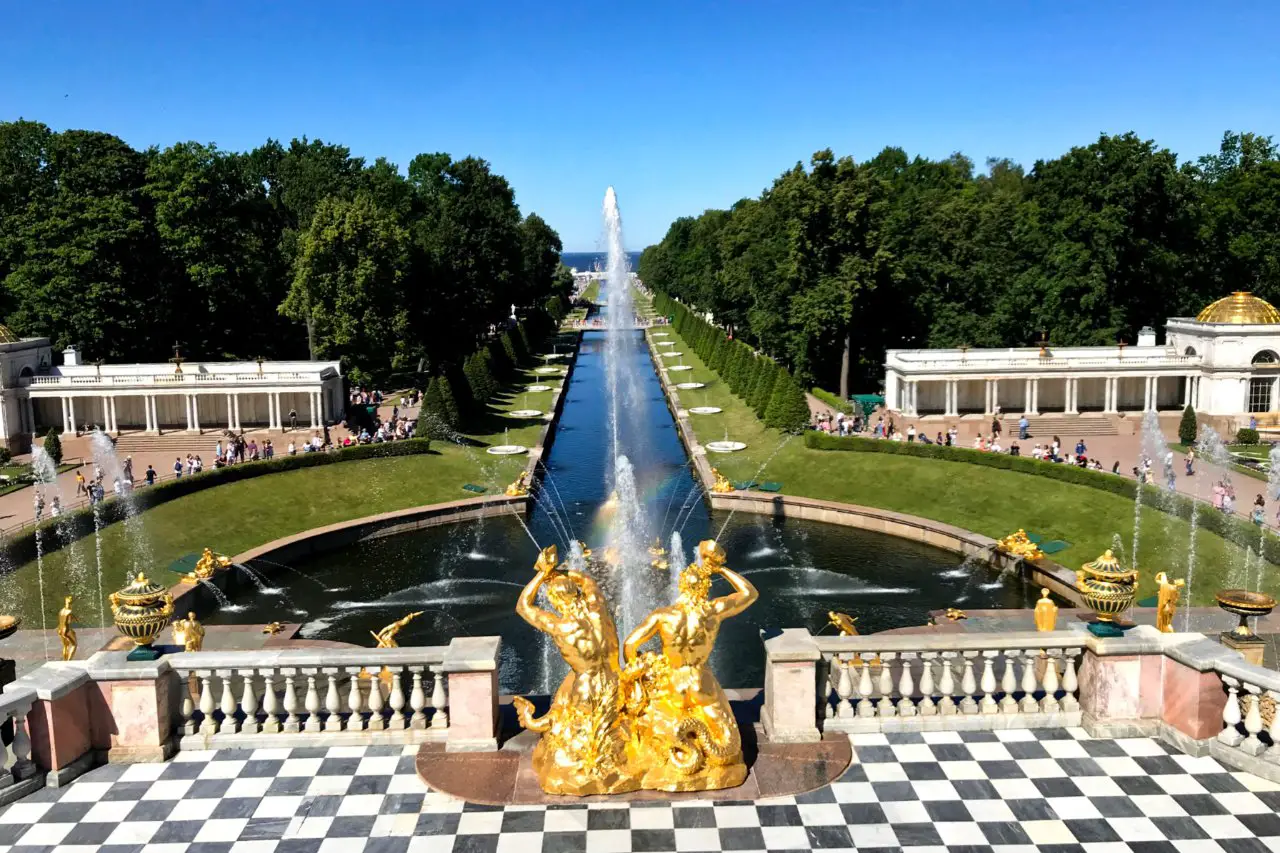
How to get to Peterhof from Saint Petersburg on your own
Peterhof by hydrofoil (speed boat)
Going to Peterhof by hydrofoil, a fast speed boat that slides over the surface of water, can be exciting and it’s the fastest way to get there if you stay in the city center. All hydrofoils leave from piers around Palace Square and the Admiralty. They usually run every 30 minutes from 10 am until 7 pm. One-way tickets cost around 800-900 RUB, you can buy it at the pier or online. The journey lasts around 30 minutes and you’ll get straight to the Lower Park and its Fountains, where you’ll need to present a valid ticket to the park to get in.
Keep in mind: Hydrofoils run only during the navigation season, usually from May to October, when the fountains are functioning.
If you don’t get seasick, traveling on a boat will allow you to enjoy beautiful views of the city and its coastal area. Although I must warn you, it can get really stuffy inside and it’s quite noisy. Hydrofoils are used almost exclusively by tourists, as we locals use it only when we have visiting friends from other cities and countries, or on other special occasion.
If you don’t want to stay only in the Lower Park, you’ll need to combine hydrofoils with other means of transport on your way back, as you won’t be able to leave the Lower Park and enter it later, and hydrofoils to the city center run only from its pier.
Peterhof by bus or marshrutka
This is the cheapest way to get to Peterhof. Municipal buses and privately owned marshrutkas –that is the word for a minivan with passengers in Russian–, run from many metro stations in the southern part of the city. They’re used both by locals, who live in Peterhof, and by tourists, albeit, mostly Russian speaking.
Pro tip: take a bus or marshrutka from Avtovo Metro station on the red line. It’s situated at the exit from the city and on the way to Peterhof, so you’ll spend less time in traffic jams. Besides, Avtovo is one of the oldest and most beautiful stations of St. Petersburg metro. It’s decorated in impressive Stalin Empire style and it’s one of the few stations that don’t have escalators, only stairs. Actually, most metro tours include a visit to this station.
As you exit the Avtovo metro station, you’ll need to cross the Stachek Avenue via the underground passage to get to the bus station. Municipal buses number 200 and 210, and marshrutkas number 224, 300, 404, 424 (424А) pass through Peterhof. The numbers might change, so the main reference point is the word ФОНТАНЫ (FOUNTAINS, literally “fantany” with the accent on the second syllable) in capital letters in Russian on the sign with the route of all these vehicles. If you ask the locals how to get to Peterhof or to the fountains, someone will be able to help.
It takes around 30 minutes to get to Peterhof from Avtovo metro station. The rates for buses are around 70 RUB one-way, and marshrutkas can be a little bit more expensive. You can use St. Petersburg public transport top-up card, podorozhnik, to pay for the ticket.
The buses are more spacious and comfortable than marshrutkas, as marshrutkas are normally hurrying around, braking sharply at almost any point at the request of the passengers. If you want to stop a marshrutka, you can do that by raising your hand. Buses will stop only at indicated bus stops along their route, they won’t react to your hand signs.
If you travel to Peterhof this way, you’ll see several palaces along the road with Congress Palace or Constantine Palace being the most significant one. It’s situated in Strelna, around 10 minutes before your final stop in Peterhof city center, and it was restored to become the residence of the President in 2003.
The former Peterhof Road was built up with the palaces of the nobility and rich people before World War II, with more than 200 mansions along it. After the war, less than a dozen survived and only a few were reconstructed.
Peterhof by train
This is my favorite. It’s mostly used by locals and Russian-speaking tourists, and it will suit you if you are not in a hurry, not afraid of communicating with local population that doesn’t speak foreign languages fluently, and if you like traveling by train to enjoy the views out of your window! Besides, the Peterhof Railway Station is very beautiful, even though it’s not in its best state at the moment. This train route is one of the oldest in the country. And, for sure, someone on the train or at the station will understand you asking for the directions if you use magical words Fountains and Peterhof.
Local commuter trains leave from Baltiyskya Railway Station, located next to the metro stop Baltiyskaya on the red line (almost all railway stations are located on the red line). You’ll need to buy tickets to the train station New Peterhof (Новый Петергоф – Noviy Petergof in Russian). You can buy them in the terminals or at the cashier desk. Locals also buy them through mobile applications, but currently they are in Russian only. A one-way ticket will cost you around 60-70 RUB. It’s better to consult the timetable in advance online, as there might be large intervals between the trains in midday. Most websites are in Russian, but you can ask your hotel or your host to help you with that.
Pro tip: Most commuter trains have toilets, and there are a few, called lastochkas (swallow bird in Russian), that are very modern. You can also use the toilet on Baltiysky Railway Station for free if you show the valid train ticket at the entrance.
The journey will take around 40 minutes. On ordinary trains you’ll meet different vendors who go from one car to another selling all type of cheap things.
Peterhof Train Station
As you approach New Peterhof Station, you’ll see a magnificent white Neo-Gothic building and it’s the sign that you must leave the train. This building was built to the design of Nicholas Benois and on the money of baron Von Stiglitz, a famous Russian philanthropist, in the 1850’s. In its spacious halls summer balls for the nobility were held. The station might remind you a Catholic cathedral, and it was, indeed, constructed as a smaller copy of the Duomo in the Italian city of Orvieto, that was reconstructed with the help of Benois.
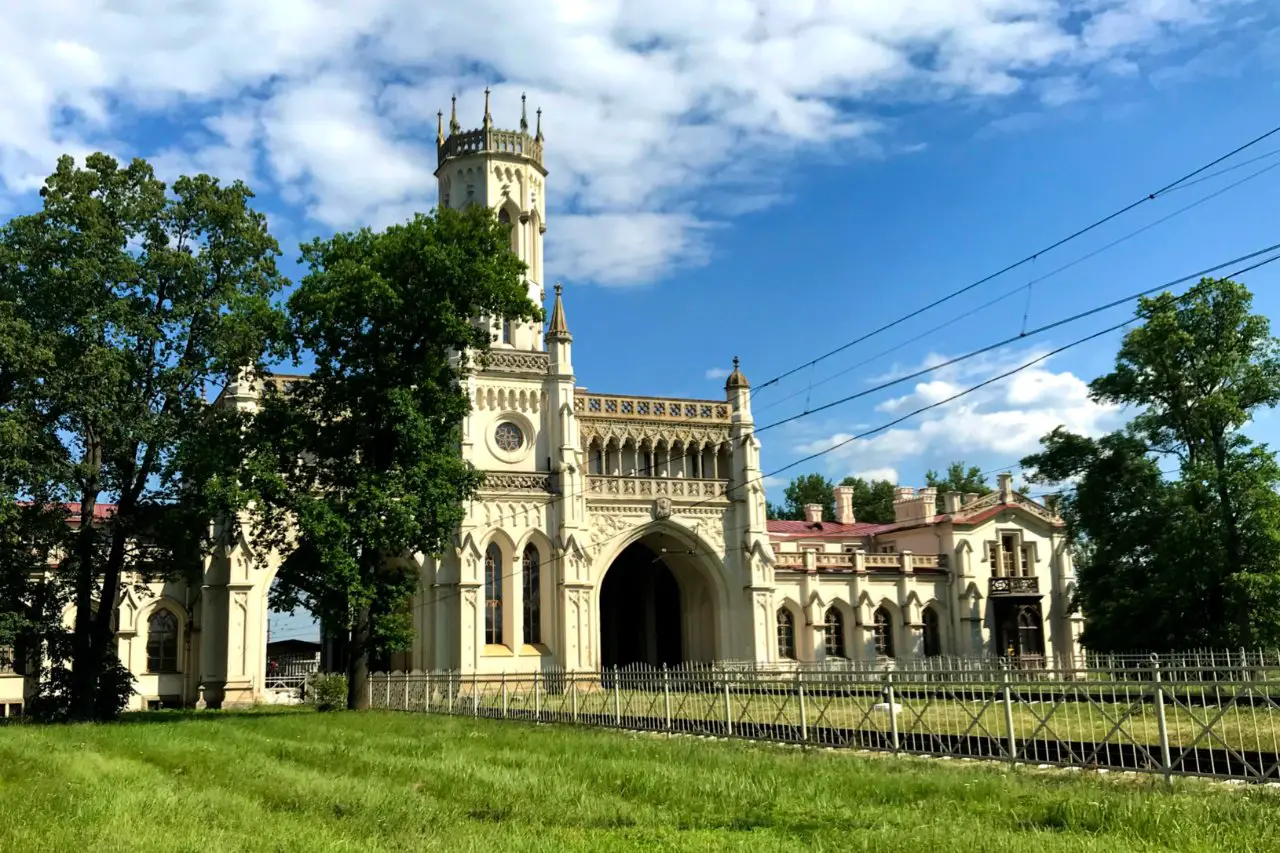
At the station, many Soviet and Russian films were shot. Unfortunately, it lost some of its original oak furniture in the course of the restauration in 2003 and now its magnificent halls are closed, as the Russian Railways still can’t finish restauration works (it’s a scandalous issue that has been taken to the court many times already). You can stroll around its platforms and see the building from different angles, imagining how it looked like during the Imperial Era.
Nicholas Benois came from a prominent Russian artistic family that was founded by a French cook who fled from France to the Russian Empire during the French Revolution. Benois created many buildings in Peterhof and his son, Leon, followed into his footsteps and became one of the most famous architects of St. Petersburg on the eve of the 20th century. Some representatives of this family still live in St. Petersburg and you can visit their family apartment with a tour. In Peterhof, there’s a separate Benois Family Museum in one of the wings of the Maid of Honor House near the Lower Park.
On the opposite side of the huge square with the station you’ll see a small garden with a bus stop and a huge park in the background. Most buses that stop in its eastern part will take you to the center of Peterhof (numbers 344, 348, 350, 351, 352, 355, and 356). A one-way ticket will cost you around 40-50 RUB, depending on whether you are using podorozhnik or paying by cash.
In around 7-10 minutes you’ll be in front of the main entrance to the Lower Park. You’ll see the Upper Garden with Fountains and the façade of the Grand Palace. Besides, in high season just before the bus reaches this stop the controller says the magical word “fountains” in Russian (remember, “fanTAny”).
Alternatively, you can take a walk to the center of Peterhof. It will take you around 40 minutes, but the town is really beautiful, and it’s surrounded by parks. Here you can see the map of the walk that goes through the part of the Alexandria Park that can be visited for free.
Best things to do in Peterhof
Lower Park and the Fountains, the Versailles of Russia
The Lower Park with its magnificent fountains is definitely the main point of attraction in Peterhof. It was founded by Peter the Great who was so impressed by Versailles in France that he decided he could do something even more impressive in his newly required lands. The scale of the fountain system in Peterhof and magnificent palaces and pavilions really take one’s breath away. Here we don’t save water –all fountains function for around 8 hours every day in the season and the water from them flows directly to the sea and never comes back to the pumping system.
You can get to the Lower Park either by sea, as Peter the Great preferred to do, or by land. If you get there by high speed boat, you’ll disembark near the red-brick Monplaisir Palace, the oldest structure in Peterhof, and in any other case you’ll enter the Lower Park from the side of a beautiful Upper Garden, that is visible from the main road. The Upper Garden in front of the Grand Palace is free to visit.
All tickets are available online on the website of the Peterhof Parks and there’re also ticket offices at the pier near the Monplaisir Palace and on the both sides of the Grand Palace. You can buy tickets to the palaces of the Lower Park on the same website or visit it with a tour.
A Little Bit of History
Peter the Great started to lay out his first residence with fountains in Strelna –in the place where now you can see the Congress Palace (Constantine Palace) if you travel to Peterhof by car or bus. Soon it turned out that the shore in Strelna was too flat and the water from the local river could not feed naturally as many fountains as the tsar wished to construct. At the same time Peter visited the estate of his attendants in the nearby Ropsha, on the hill to the south of Peterhof, and was impressed by the abundance of natural springs in that area. He decided to redirect water from Ropsha hills through the canal with artificial lakes to the coastal area –this is how the Lower Park was born. The fountain feeding system became a miracle of the engineering thought and it has been working without interruption since the 18th century.
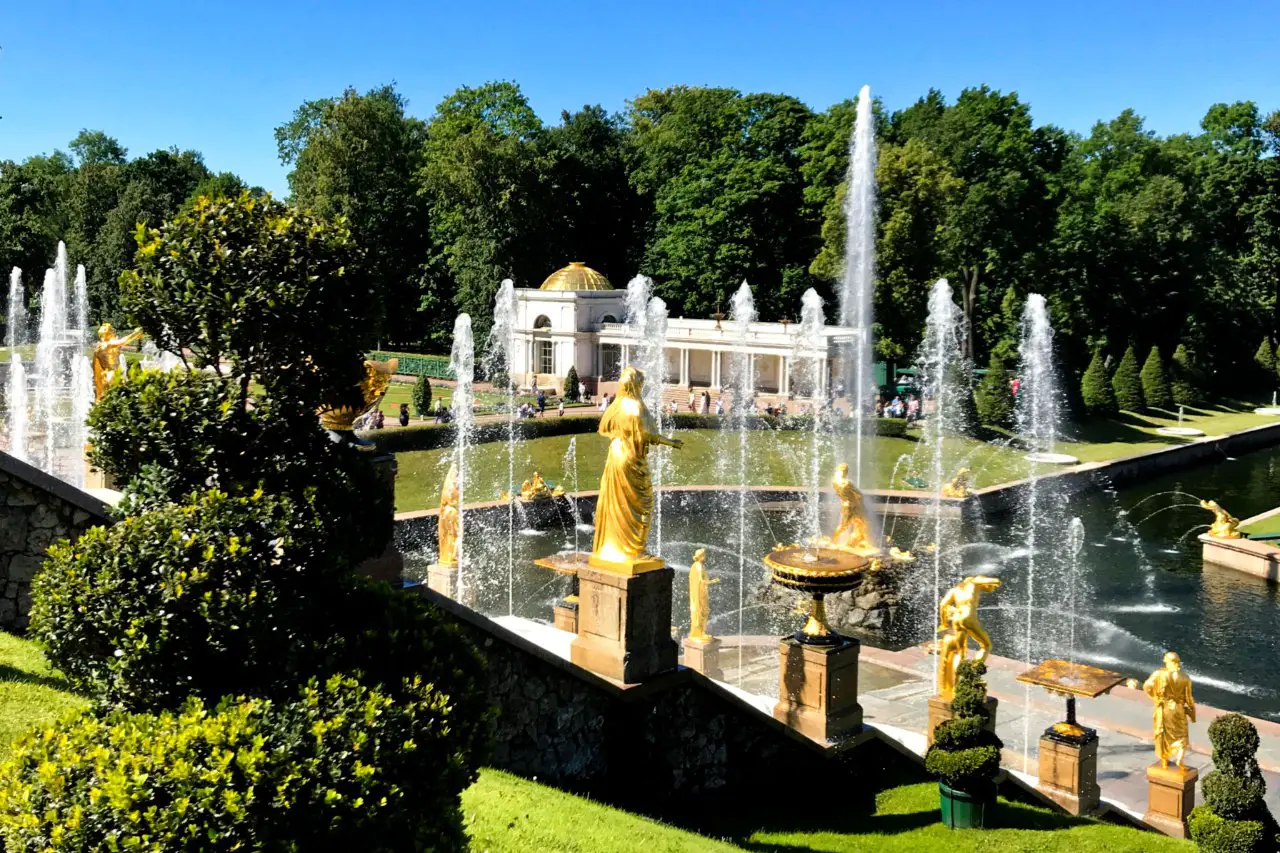
Peterhof’s Fountains
The keystone of the composition of the park is the Fountain of Samson, who is tearing apart the jaws of a lion –an allegory of the victory of Russia over Sweden in the Northern War, in the course of which St. Petersburg was founded on the recaptured territory. Apart from that massive fountain that spews out the water with such force that everyone who stands near gets immediately wet, there are other fountains of all types in the park and it’s a great joy to explore them! Here you’ll find fountains-cascades, fountain temples, the Sun fountain, Roman fountains, and numerous trick fountains. You’ll need around 1,5 to 2 hours to see them all and appreciate the whole beauty of the park’s composition.
Most fountains were destroyed by the Nazi during World War II, and they are still being restored. The initial water feeding system of the 18th century survived, and today engineers don’t fully understand how it works. Samson was the first fountain to be restored –it was opened in 1947. Just few years ago, the remains of an old labyrinth with fountains were discovered on the border of the Lower Park with Alexandria, and it has recently been rebuilt from scratch. So, the restoration in the park is an on-going and very exciting process that may result in some amazing findings!
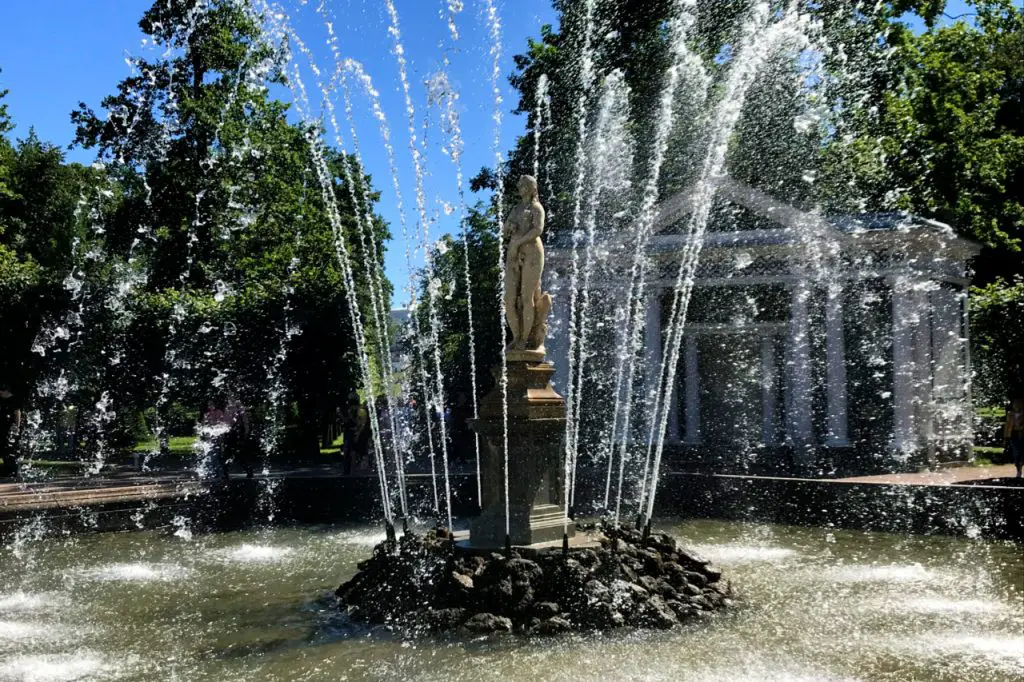
Monplaisir Palace
There are several palaces and pavilions in the Lower Park –Monplaisir is the oldest and the most authentic of all of them. This modest mansion in Dutch style was the favorite place of Peter the Great as he loved looking at the sea from its large windows. It’s the only stone palace of Peter that survived, and the only building in the Lower Park that was not destroyed by the Nazi during World War II, although its interior was badly damaged. The old linden and oak trees in front of it also survived from the Imperial Epoch. All the other trees in the garden were cut down during the war and planted anew later.
I really recommend you visiting it with a tour. You’ll see the things that belonged to Peter I (they were evacuated during the war) and see his collection of Old Masters’ paintings. Its main masterpiece, a work by Rembrandt, is now in the Hermitage Museum. The entrance ticket fee to Monplaisir is cheaper than to the Grand Palace and even though it has a lot of visitors during the season, it doesn’t get as crowded as the Grand Palace.
Monplaisir is open only from May to October and it can be closed on the days with heavy showers with no prior notice.

Grand Peterhof Palace
This huge Baroque palace was created during the reign of Peter the Great’s daughter, Elizabeth. Pompous Baroque style satisfied her needs perfectly, as she led a life full of balls and masquerades. For these occasions, its gala rooms were richly decorated with gold, marble and mirrors. The palace, built to the design of Bartolomeo Rastrelli, looks more spacious from the outside than it really is –inside it’s quite narrow with a lot of tiny rooms, so it’s a great optical illusion that surprises all its visitors.
It was used mainly for lavish receptions, balls and ceremonies, Russian tzars and tzarinas didn’t live there.
Most items from the palace were evacuated at the outbreak of the war, so they survived. The palace itself was almost completely destroyed by the Nazis during their retreat. It was recreated using the old technologies of the 18th century after the war.
As it gets really crowded in the season, I recommend visiting off season, when the fountains are shut down and the palace is half empty. Otherwise prepare to spend a couple of hours inside surrounded by large tourist groups.
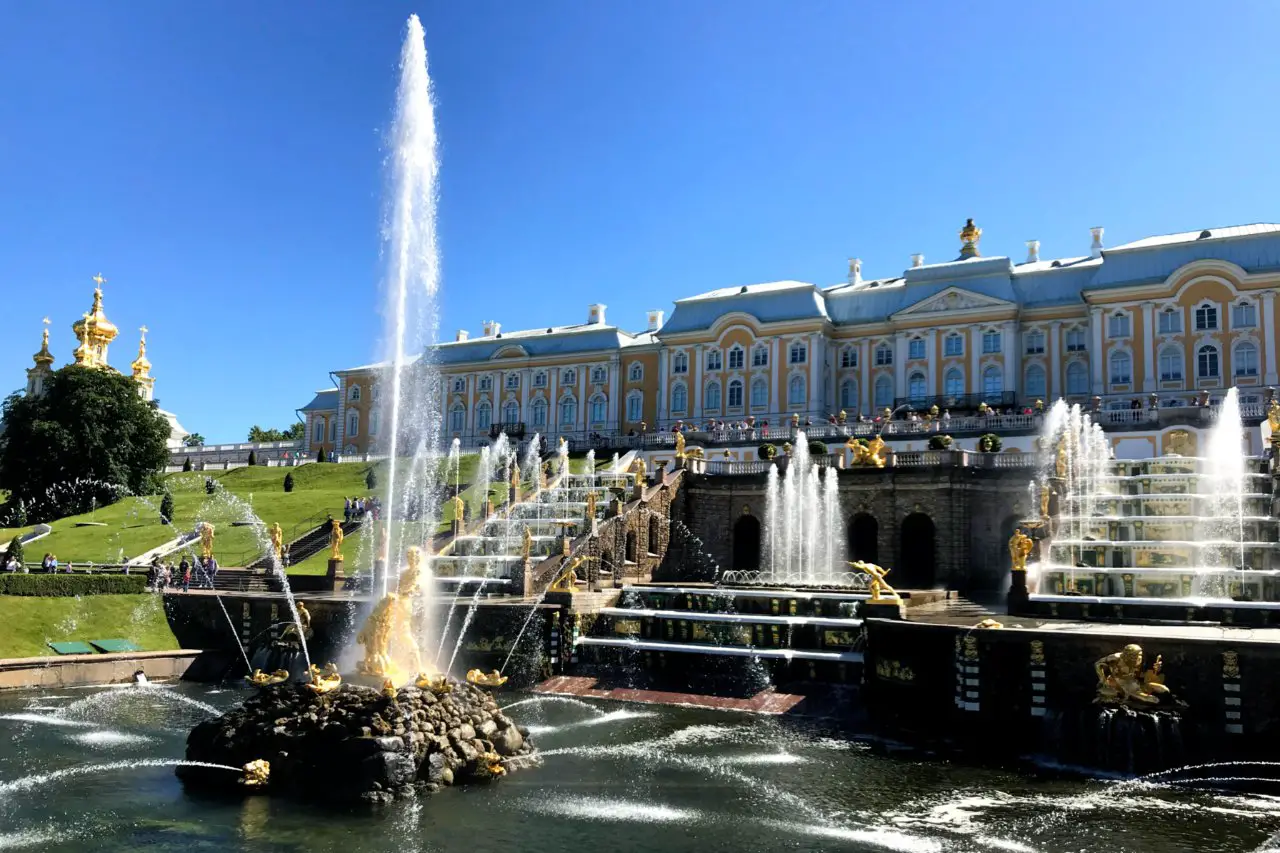
Alexandria
There are other pavilions in the Lower Park that house some interesting exhibitions from time to time, but if it’s your first visit of Peterhof, I strongly recommend you to leave them behind and explore Alexandria, another great park with mansions where some Russian emperors actually lived.
You can quickly examine Alexandria on a tourist train that leaves from the Lower Park and returns to the same place. It has audio guides in several languages and the whole journey will take you around 30 minutes. The tickets cost around 700 RUB.
For a more relaxing walk in Alexandria and a visit to some of its mansions you’ll need to get there by foot. And it’s definitely worth it.
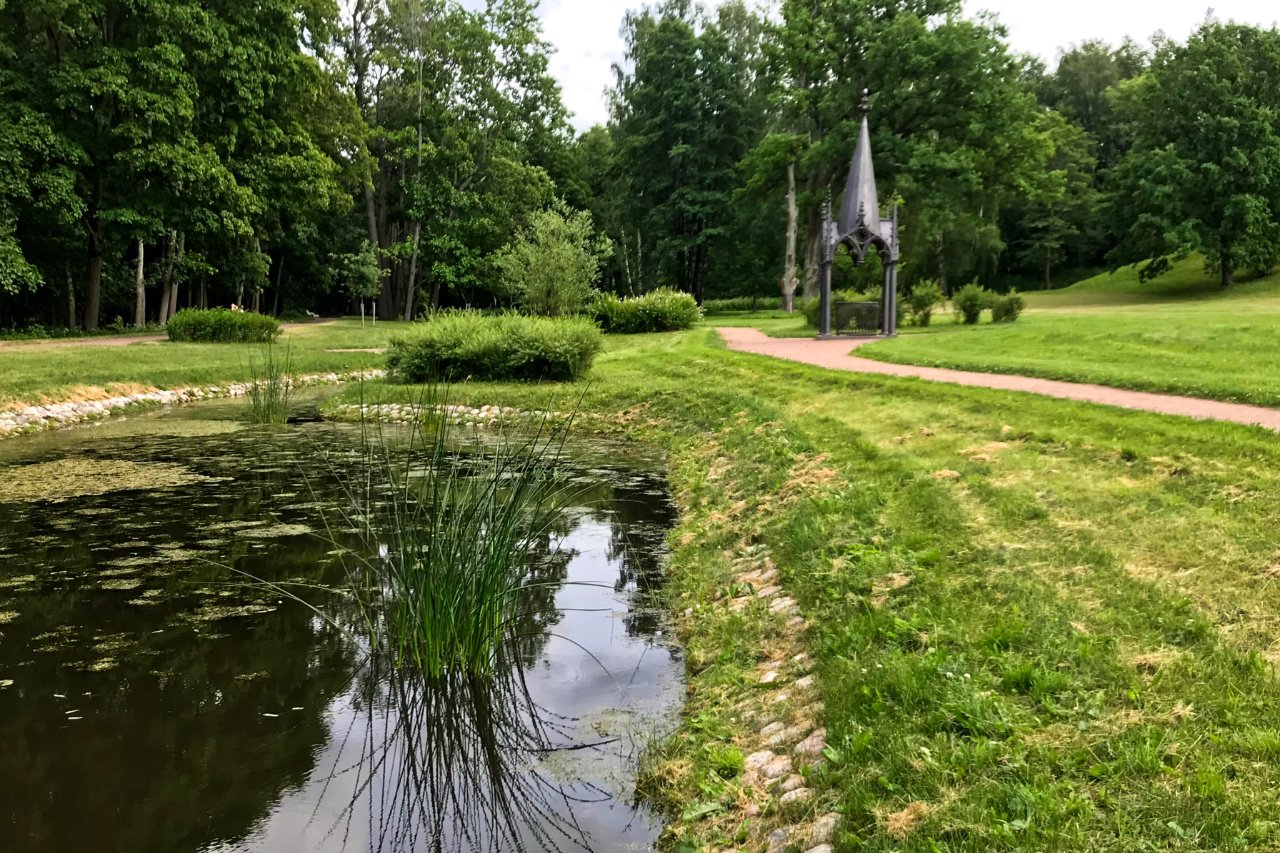
If you leave the Lower Garden from its eastern side, with orangeries and a toilet where it borders with Alexandria, all you’ll need to do is to turn left and get to the entrance. There is also an alternative exit that leads right from the Lower Park to Alexandria.
Before you delve into romantic Alexandria, take a look at magnificent red-brick Neo-Gothic stables that will be in front of you if you get there passing the orangeries! It’s one of my favorite sights in the city and most tourists never get to notice them, even though they are so close to Peterhof’s main sights.
Imperial Stables
This is one of the most romantic spots of Peterhof, admired by cinema and photography lovers. The stables were built in the mid-19th century in the Neo-Gothic style to the design of Benois, who was also the architect of the Peterhof Railway Station. Empress Alexandra, the wife of Nicholas I, was very fond of this style and since the emperor was the main developer of the town in the modern sense of the word, and he loved his wife, you can find a lot of Neo-Gothic buildings in Peterhof.
Can you believe that the ensemble of stables occupies the whole quarter surrounded by 4 streets? If not, then go and take a look.
In the imperial times the stables were the home to 330 horses. Its manege, that has been recently reconstructed, has a magnificent wooden floor made of fumed oak and linden tree. All premises of the stables have large lancet windows that required no extra illumination during daytime. When horses grew old, they were not killed, but sent to the stables for retired horses in the Tsar’s village (present-day Pushkin), where they lived peacefully.
During World War II the stables were turned into a hospital and gestapo by the Nazi. The buildings were not destroyed.
In the Soviet Era and up to 2013 the former stables housed a sanatorium with healing water that was extracted right at the same spot. Until recently it was possible to buy it. I remember that it was very salty, but it’s said that salty waters are very beneficial for your health!
Some Soviet and Russian films were shot there. At the moment, the stables are slowly decaying and waiting for someone to restore them at last –and I hope that those who can do it will appear soon!
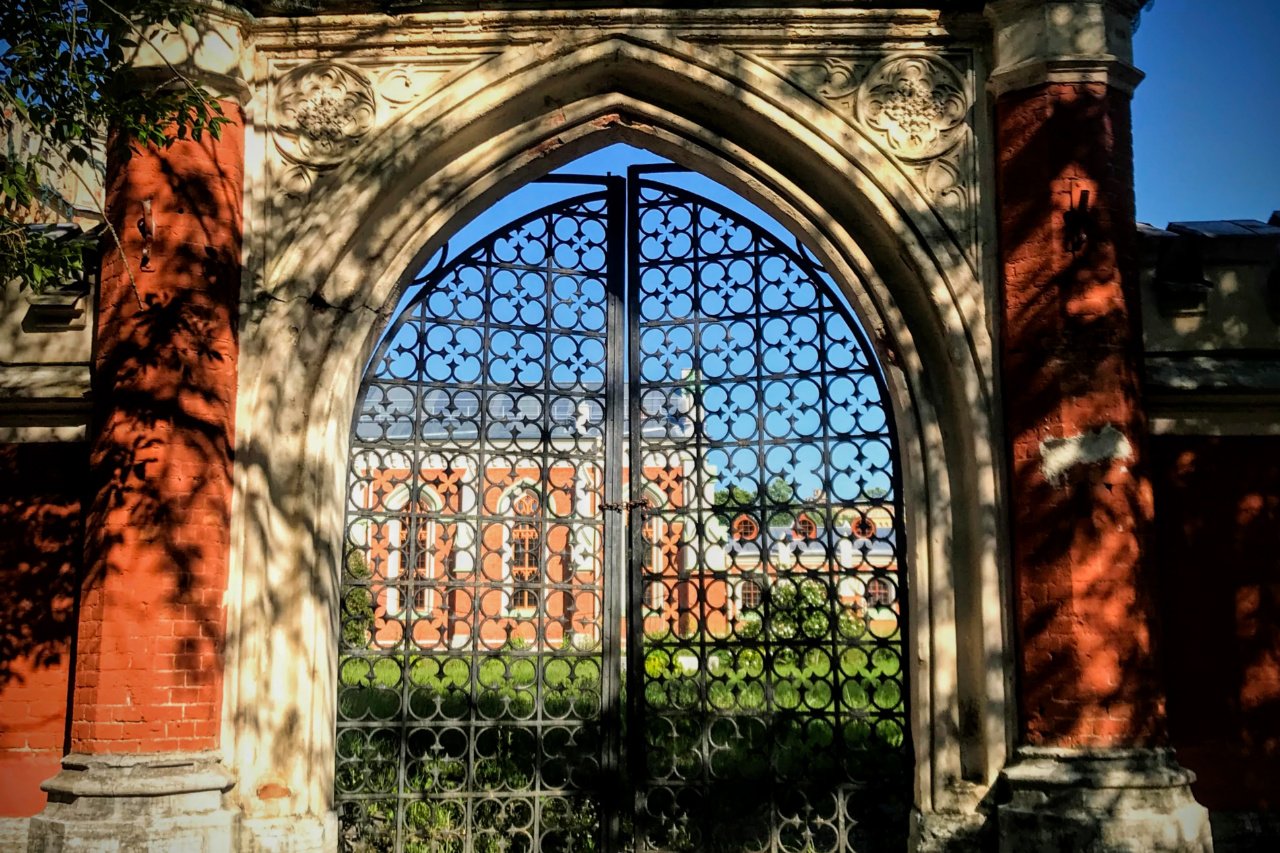
Alexandria Park
You can buy tickets to Alexandria and its museums online on the official website of Peterhof Museum or in the ticket offices located at each entrance to the park and its museums.
If you are interested in a full-day Peterhof Tour visiting one of the palaces, a touristic train, Alexandria and Lower Park, see our tour, and we will be happy to modify it according to your interests.
In my opinion, Alexandria, that boasts wonderful views over the sea and lovely fresh air, has a type of mysterious, peaceful and romantic atmosphere that inspires you and calms you down. There you can feel how the palace fashion changed with time.
Budget tip: a part of the park that is closest to the Peterhof Railway Station is wilder and it’s free to visit.
In the 18th century Alexandria used to be a menagerie, that’s why it’s so huge. The imperial part with former royal residences received its current layout of a landscape park during the reign of Nicolas I in between the 1820’s and the 1840’s. By the 19th century the sumptuous Lower Park with its Grand Palace, full of luxury items, gave the way to more homely lifestyle of the royal family and the modest atmosphere that surrounded them.
It got its name in the honor of Nicholas I’s wife, Alexandra. Peterhof and its surroundings are filled with buildings, churches, parks and entire villages that bear the names of Nicholas’ children and spouse. It was his favorite residence and he spent there most of the summers with the family, gradually turning Peterhof into a perfect place for lovely long walks and peaceful relaxation.
Nicholas I was fond of his wife, but he was also somehow very passionate, so after Alexandra gave birth to 7 children, the doctors advised him to refrain from intimacy with the empress, as it was dangerous for her to become pregnant again. Nicholas followed the advice and he started having relations with other women. He must have felt guilty because of it and he did his best to please Alexandra. Maybe it’s the reason why there are so many places and buildings in Peterhof that were created for her and named in her honor.
During the war, this park witnessed some fierce fighting. Its main buildings were damaged, but not destroyed, as in the Lower Park. After the war, the park lost its initial layout and began to look more like a forest. Not a long time ago it was reconstructed, extra trees were taken out and now it looks more like it did during the imperial era. During the recent reconstruction, such interesting details as the children playground with wooden sports equipment or amusing fortresses where several generations of young Romanovs played were recreated.
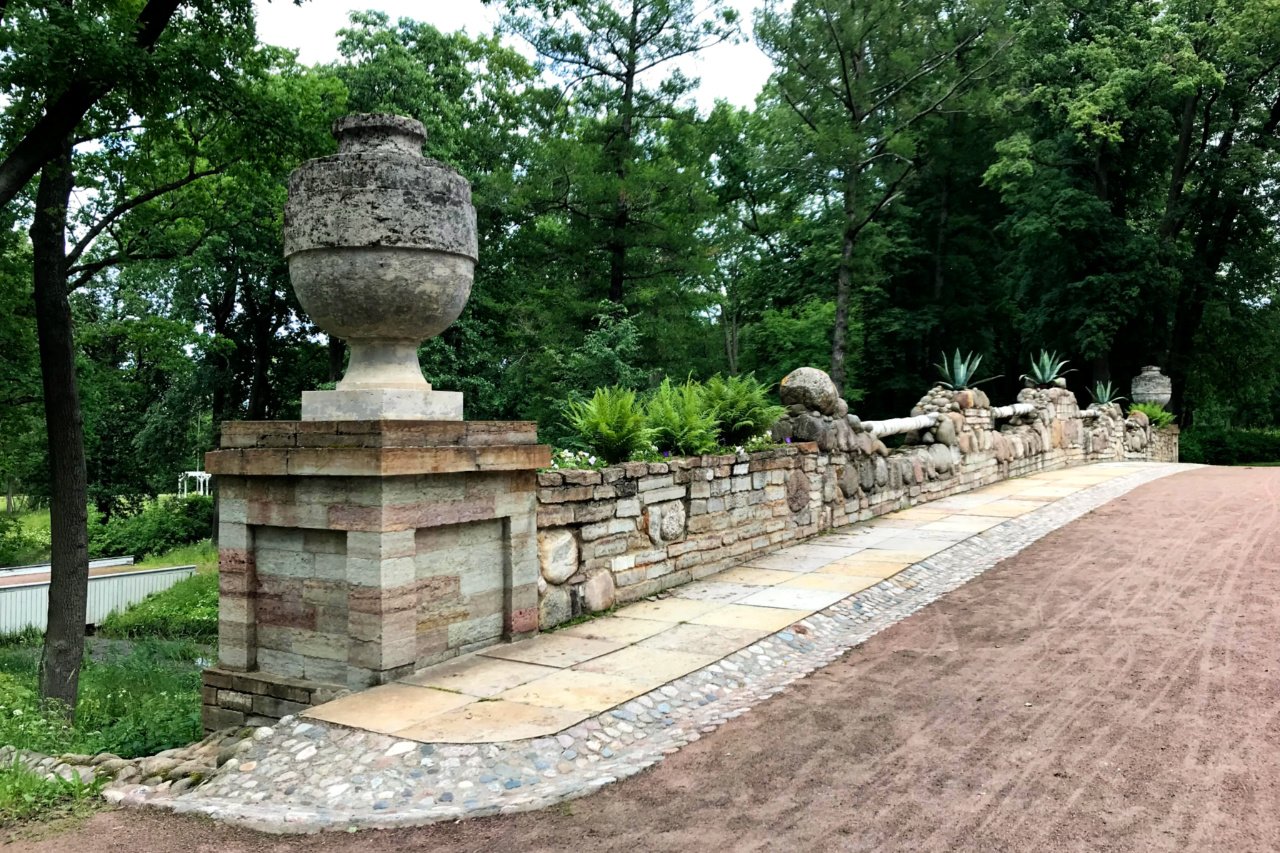
Alexandria’s Main Sights
Cottage
This cozy mansion was built for Nicholas I and his family in the style of an English country house, in 1829. Just like many other buildings in Peterhof and Alexandria, it has elements of Gothic architecture –and now you know why!
It’s hard to name this building a palace, so small and modest it is. Here in rather humble conditions all the children of the emperor were growing up. The cottage boasts wonderful views over the park and the Gulf of Finland. From here Nicholas I walked to his office in the Grand Palace each morning.
I really recommend you visiting the Cottage with a tour –you’ll see many authentic items that belonged to the royal family and, besides, the building itself survived the war.
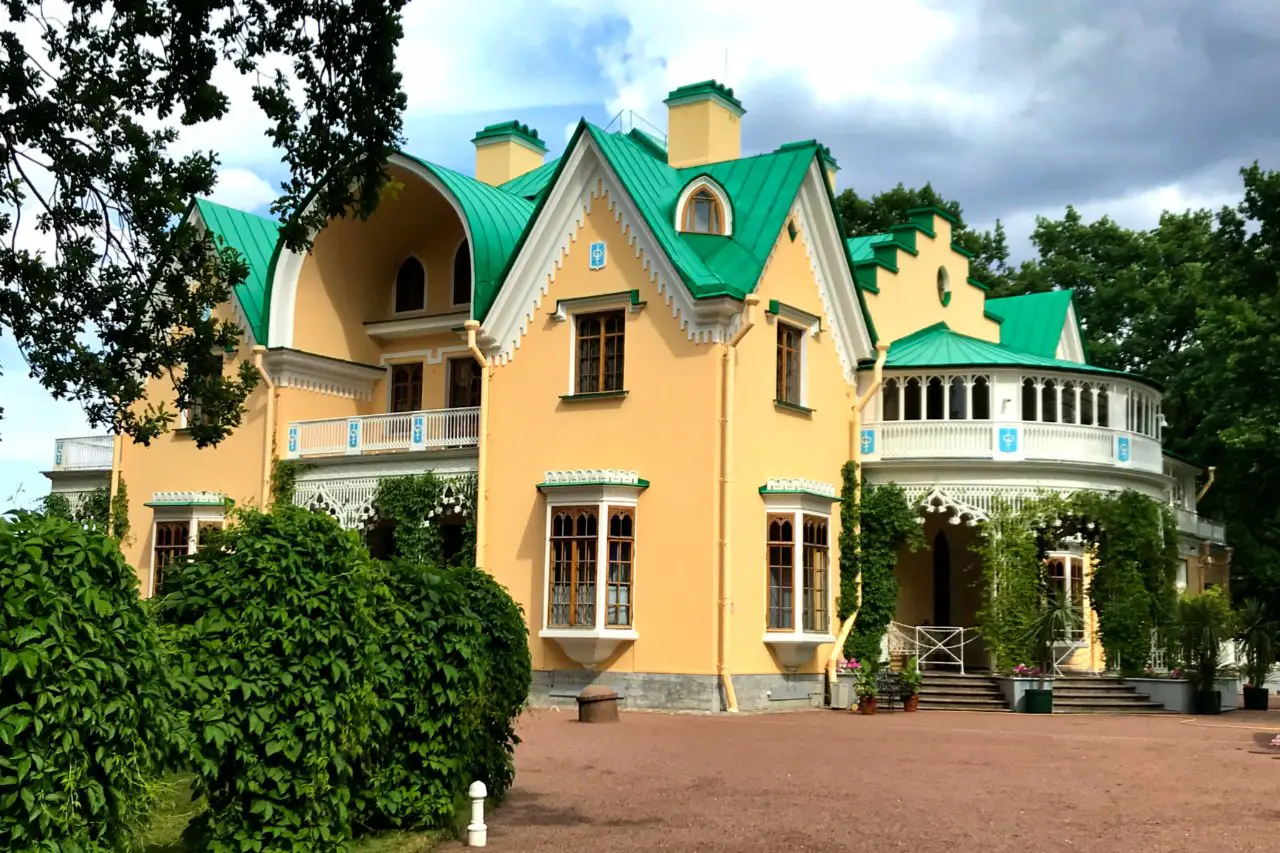
Gothic Chapel
This photogenic chapel is probably the most popular spot for photoshoots in Alexandria and it’s on the majority of the park’s photos in all seasons! Despite its Gothic design, it has always been an Orthodox church where the services for the royal family were held. Inside little has survived from the imperial time, although the building itself is authentic.
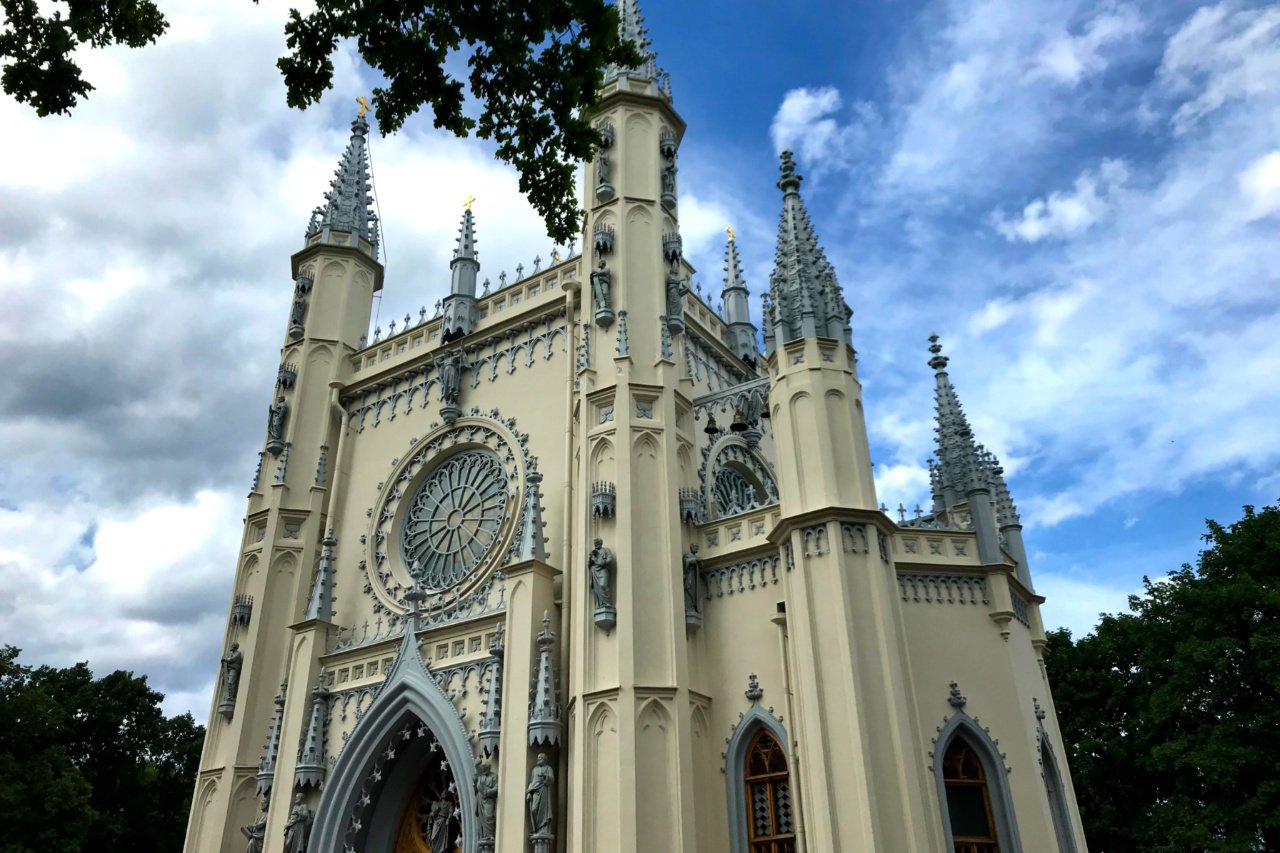
Farm Palace
This used to be a small farm that supplied the royal family with dairy products. The cows and cowherds were invited from England. When Nicholas’ elder son, future emperor Alexander II, grew up, the farm was extended and turned into his mansion. Alexander and his family lived there for 30 years. Throughout the reign of Alexander II, it continued to be his only residence.
The mansion was partially preserved during the war, but it was damaged during a severe fire in 2003. Now it’s reconstructed and open for a visit –from its exposition you can find out about Alexander’s family and the country life of Peterhof, for it was a popular destination for summer cottages before the revolution.
Alexander II, also known as the Tsar Liberator, abolished the serfdom in Russia and granted many liberties to some autonomous regions of the Russian Empire, such as the Principality of Finland. He was very modest in his everyday life and, apart from the Farm Palace, he did not have other residences.
During his reign, the first wave of terror occurred –he survived 6 attempts on his life, which were prepared by people of different beliefs and ethnicities, acting on their own or as members of secret terrorist organizations. The tsar died after the 7th assassination attempt that took place on the Griboedov Canal Embankment where later the Church on the Spilled Blood was erected in his memory.
Nicholas II was another prominent resident of Alexandria. His country house was situated on the seashore, on the border of Alexandria with another former estate, Znamenka. In 1941, Soviet landing force, known as the Peterhof Landing Operation, came here by sea from Kronstadt and it was almost totally destroyed by the Nazi. You can see the memorial sign commemorating this terrible event on the seashore, close to the ruins of the Summer House of Nicholas II.
The country house is currently being recreated from scratch. It seems that the interest to the family of our last tsar is so strong that this project got priority over others. In that house Nicholas II signed the manifesto on the entry of Russia to World War I, and there his son Alexey was born.
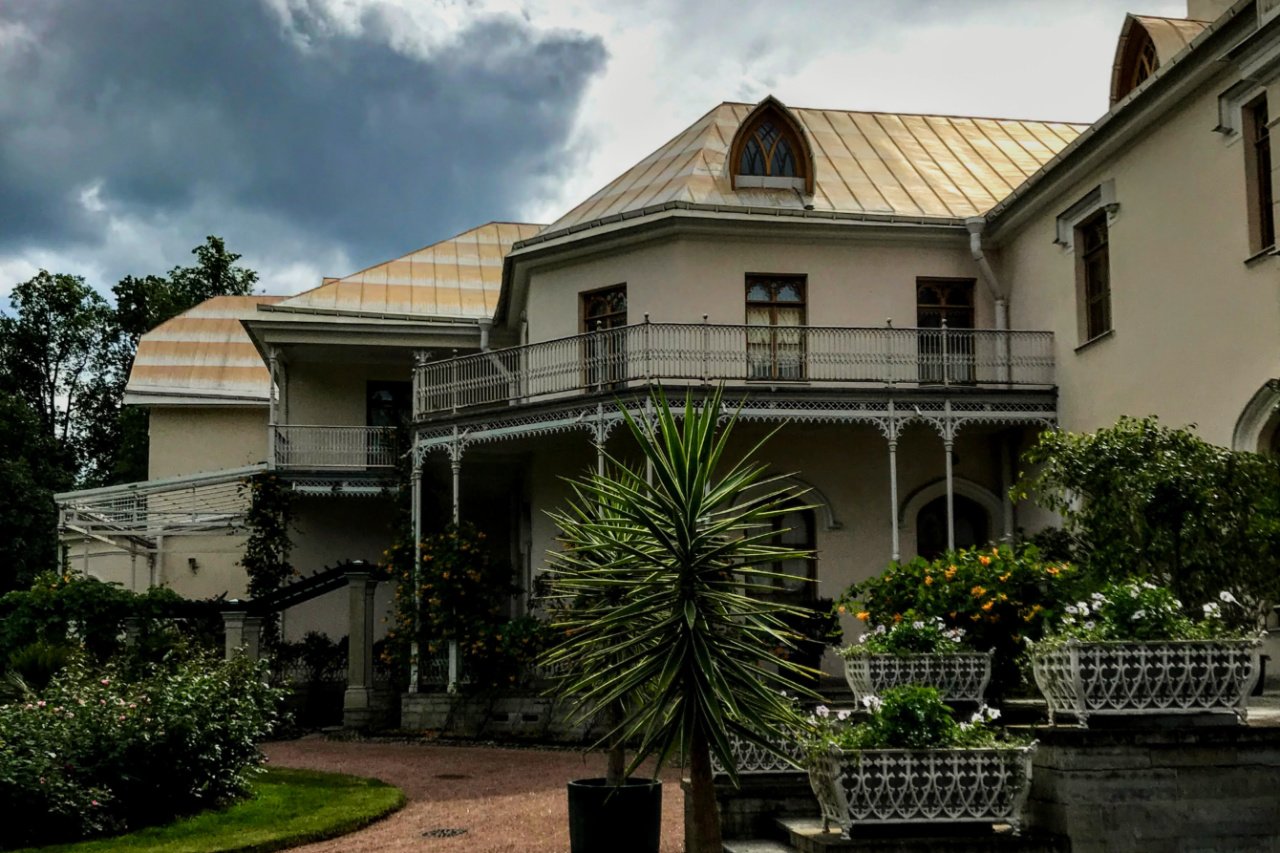
Other Routes to explore Peterhof
Route 1. Visit of Island Pavilions (1-2 hours)
Opposite the entrance to the Upper Garden, across the road and behind the Hotel New Peterhof, a cathedral in Russian style and two wooden mansions, you’ll see the Colonist’s Park with one huge artificial lake, called Olga’s Pond. This pond has two small islands with royal pavilions. They are designed in the style of the ancient villas of Pompeii and Southern Italy, and you can visit them with a tour. If you are planning a visit on your own, the tickets are available on the website of the Peterhof Museum.
The pavilions, park and a pond were created at the time of Nicholas I on the swampy area to the design of A. Stakenschneider and P. Erler, the chief gardener of Peterhof. Nicholas devoted them to his wife and the second daughter, Olga. The park received its name from a colony of German settlers that was situated nearby. And the islands were only accessible by boat or ferry. Now they’re connected to the mainland with a bridge.
Tsarina’s Pavilion and Island
It belonged to Alexandra, hence its name in Russian. There she could take some rest from the family and work on her projects in her parlor. It wasn’t destroyed during the war, as it was used as an observation point, and you can see some original mosaics on the floor.
Olga’s Pavilion and Island
The island with a pavilion was presented by Nicholas to his daughter Olga as a wedding present. It has a “paradise garden” with peacocks and other exotic birds.
On the island, various ballet performances took place in the summertime for the royal family and their guests. The stage was floating on the water of the pond. In these performances participated such ballet primas as Mathilde Kschessinska, the first love of Nicholas II, Tamara Karsavina and Agrippina Vaganova. During the war the pavilion was burnt down.
Wooden Mansions
A beautiful wooden mansion on the main road in front of Olga’s Pond and another one next to it are among few wooden estates that survived during the 20th century. Before the revolution they belonged to Khrushchev, a wealthy citizen of Peterhof (not related to Nikita Khrushchev) and in the Soviet times there was a grocery store in one of them. Now they’re used as the administrative buildings of the Hotel New Peterhof.
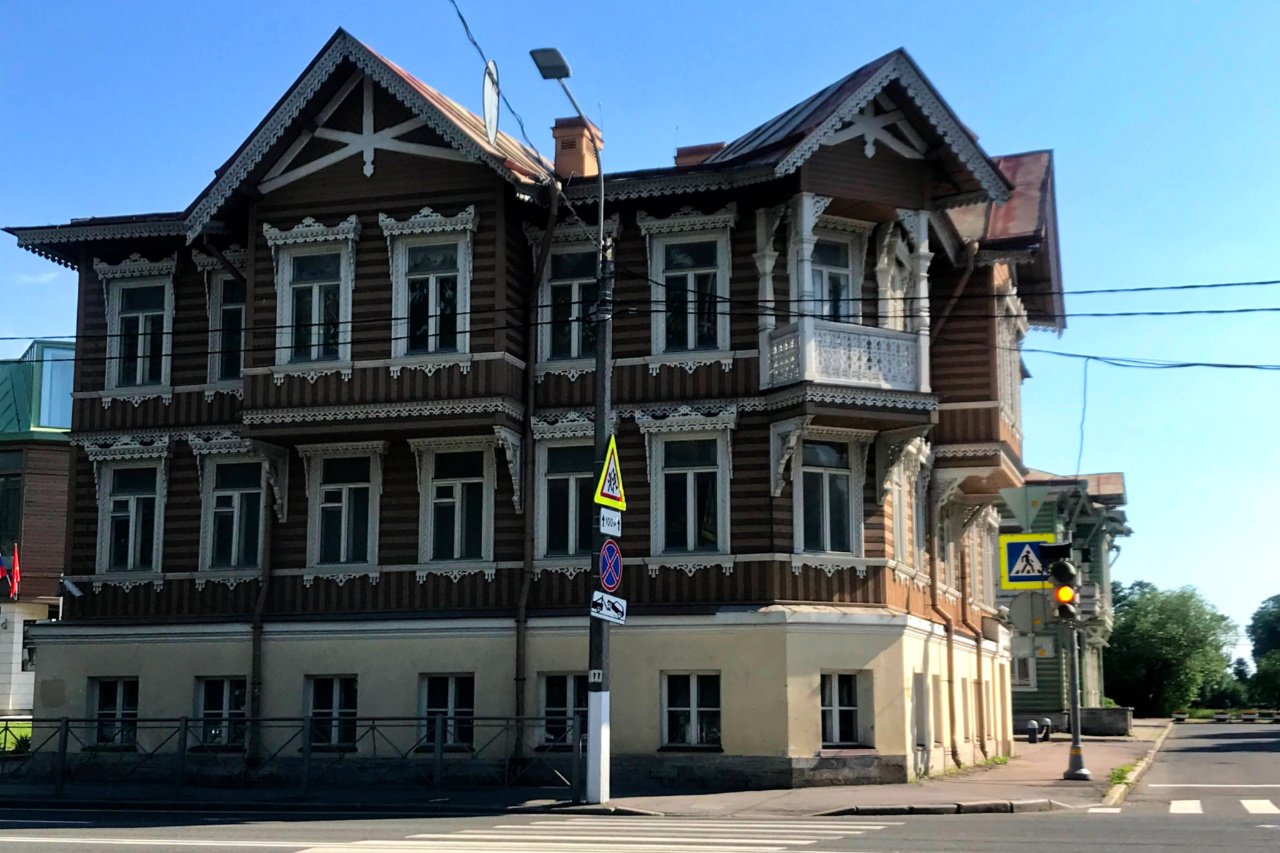
The Cathedral of St. Peter and Paul
This beautiful cathedral in Russian style will remind you of the Church on the Spilled Blood. Just like the church, it was built during the reign of Alexander III, the grandson of Nicholas I.
Fun fact: if you see a structure in neo-Russian style in St. Petersburg and its surroundings, it’s very likely to be built at the time of Alexander III –he loved all things Russian and considered himself truly Russian, even though he hardly had any Russian blood in his veins.
It’s the tallest building in Peterhof and it’s one of the main landmarks for sailors, as it can be seen far from the sea.
In the atheistic Soviet Union of the 1930’s it should have been demolished, but the locals flooded the basement of the cathedral when they opened the locks of nearby canals, and so the demolition had to be postponed. Then the war broke out and the cathedral became the main structure from which the Nazi shelled the waters of the Gulf of Finland. They were, in turn, shelled by the Soviet aviation. So, the cathedral was damaged, but finally survived. In that state, it stood up until the 1980’s when it was decided to restore it. I was baptized in it in the beginning of the 1990’s and I remember that inside it was still on restoration. Now it’s being renovated again, but, hopefully, soon you’ll be able to see it in its full glory!
Route 2. Walk in the Meadow Park (3-4 hours)
The Meadow Park (Луговой Парк in Russian) is hardly known to any foreign visitors of the city, as it’s situated aside from the main touristic routes, behind the railroad. It consists of a system of 8 artificial lakes with islands, a river and a canal, all feeding the fountains. It was laid out at the time of Nicholas I who loved taking long walks and making picnics in that area.
In the park, you’ll see a significant part of the water system of the fountains, old oak and linden trees, planted there in the mid-19th century, beautiful administrative buildings of the Tsar Mill, Belvedere Pavilion and the ruins of the Pink Pavilion.
It’s easier to take a taxi from central Peterhof or its railway station to get there –the journey will take you around 5-10 minutes, depending on your location.
The park is free to visit and it’s the favorite recreational area for the locals. They like cycling along its main canal that stretches for many kilometers up to Ropsha, making barbecues and, on hot summer days, sunbathing and swimming in the lakes.
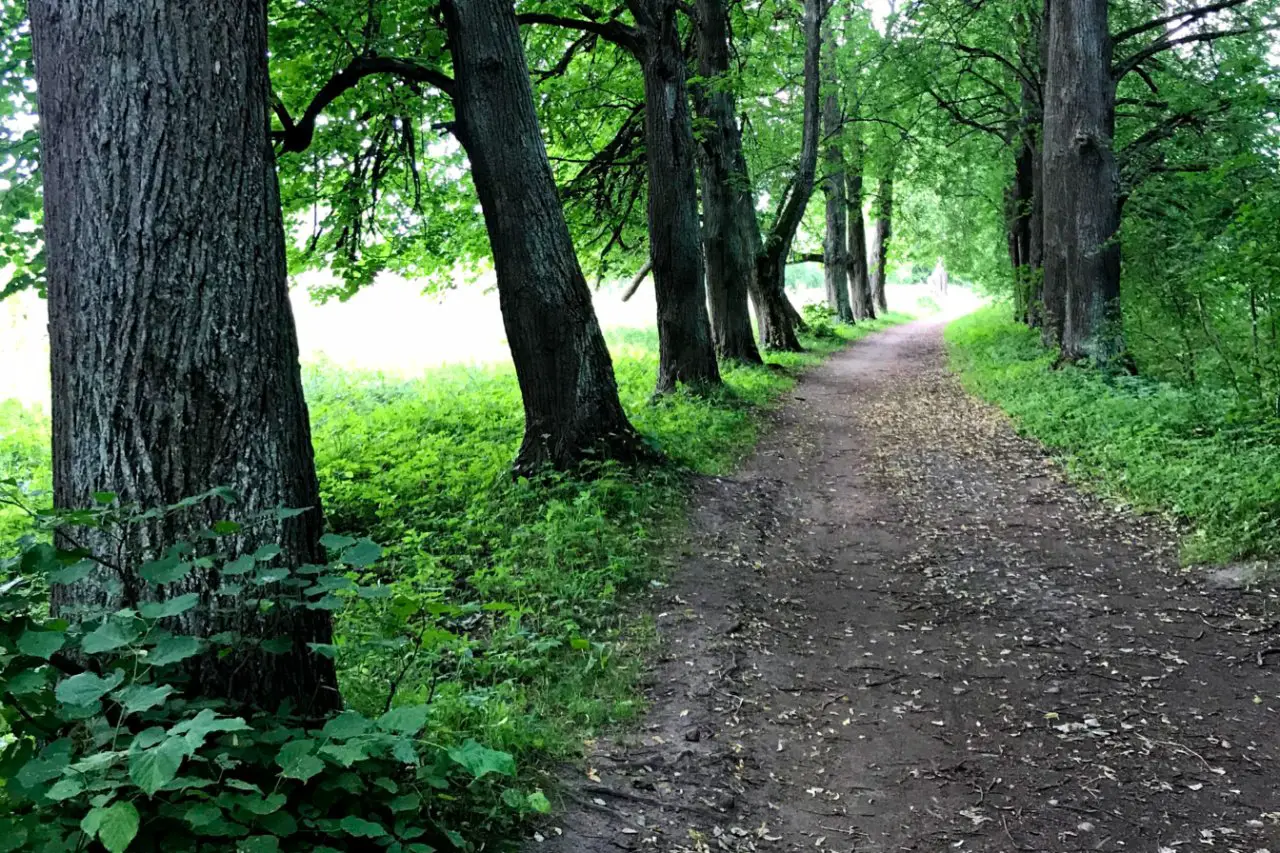
We are very happy that the park is now being reconstructed –the lakes have been cleaned, and its shores have been reinforced with stones, so it’s slowly returning to its initial layout.
Close to the railway you’ll see the ruins of the Pink Pavilion and in the middle of the park there are charming wooden administrative buildings of the Former Tsar Mill, that was built by the order of Nicholas I for local peasants. These buildings have miraculously survived to our day and they have recently been reconstructed on the money of a local entrepreneur who saved them from destruction.
In the end of the park, high in the hill, you’ll see the Belvedere Pavilion that reminds us of ancient Greek temples. It boasts breathtaking views over the surroundings –you can even see the Gulf of Finland from it! It was built to the sketches of Nicholas I and finished after his death. During the war, it was not destroyed and now it’s maintained by a local entrepreneur, who reconstructed it. It serves as a venue for private events, and it can be rented for a modest fee.
On the opposite side of the pavilion, on the other hill across the road, you’ll see a white church in Classical style –this is St. Alexandra’s Church, the last building that was constructed in Peterhof during the reign of Nicholas I. Up until the 2000’s it stood there without its cupola and stucco molding, as a silent reminiscent of the war, but now it’s being slowly reconstructed on the money of locals.
Belvedere and the church stand at the hills from which empress Alexandra loved observing Peterhof and its surroundings. And, now, although the adjacent territories have been built up by all types of housing, the view is still impressive.
Keep in mind: the park does not contain toilets or cafes and it takes around 1.5 hour to cross it from one side to another.


Other imperial residences nearby
If you decide to stay overnight and see other imperial parks near Peterhof, here are the most famous estates:
Znamenka Estate
This huge park starts just to the east of Alexandria and it has a beautiful, but somehow neglected palace with the ruins of stables. Before the revolution, it was used as the residence for foreign diplomats and royal families coming to Peterhof with a visit.
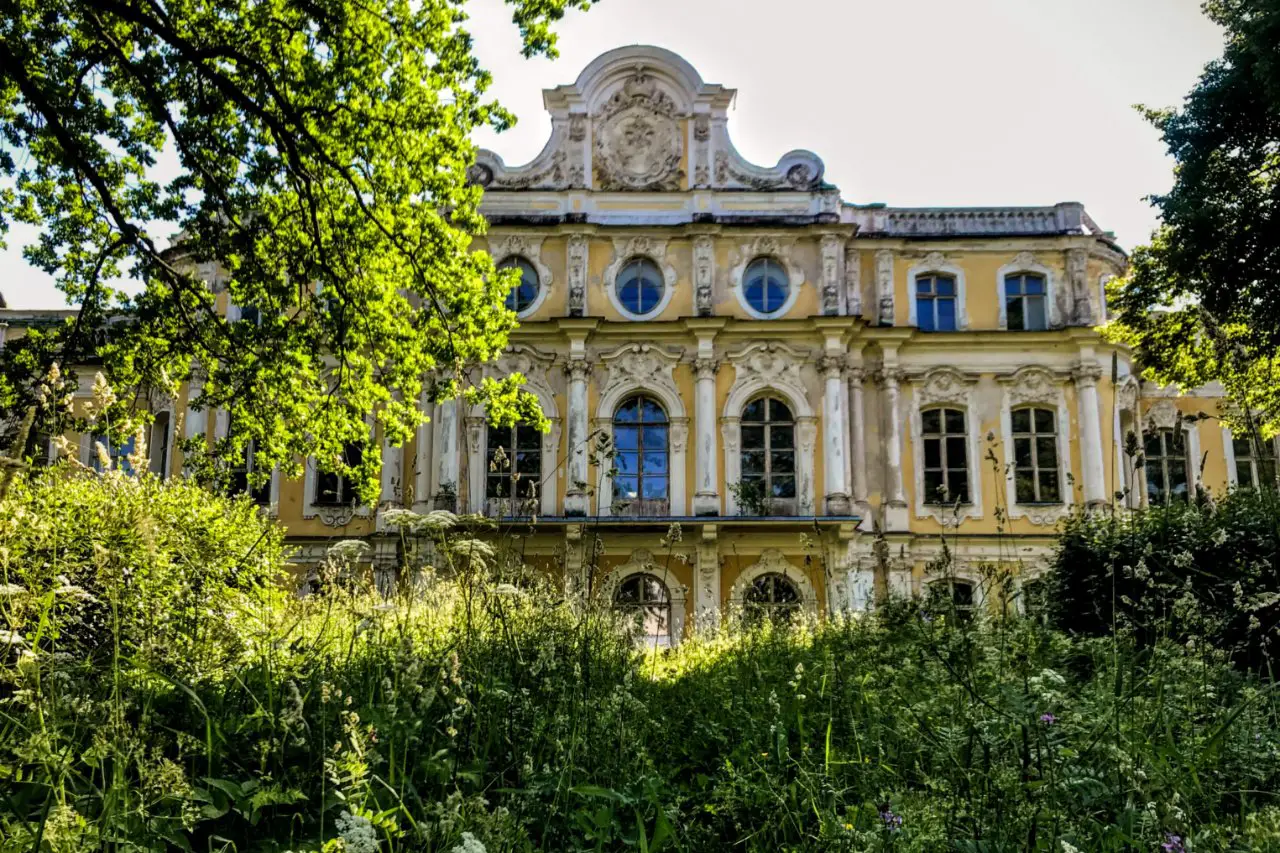
The National Congress Palace (Constantine Palace) in Strelna
It’s situated further to the east from Znamenka, on the way to St. Petersburg. As stated before, this is the place where Peter the Great initially planned his Versailles. This huge palace belonged to emperor Paul I, then to his son Constantine, and later to one more great duke Constantine, so in Russian it’s primarily known as the Constantine Palace. Severely destroyed in the war, it was reconstructed in the 1950’s and later in the 2000’s to become the official residence of the Russian President. Here the G8 Summit and other international receptions took place. Now it also houses the collection of famous Russian artists Mstislav Rostropovich and Galina Vshnevskaya, and you can visit it with a tour.
Near the Congress Palace you will find an old wooden house from the 18th century –the homestead of Peter the Great, which miraculously survived through the centuries and the war. It’s now open for visits, and you’ll find some of Peter’s personal objects inside. You can buy tickets on the official website of the Peterhof Museum or in the house itself, but keep in mind that it’s often closed, especially during the weekdays.
You can get there by tram from Avtovo Metro Station –one of the oldest tram lines that was meant to connect St. Petersburg with Peterhof and Oranienbaum before the revolution, although it reached only Strelna.
Know before you go: The tickets to the palace are available on request, as on some dates it may be closed for state events and the receptions. Check its official website for current information.
Sergievka
This idyllic estate is situated on the hills between Peterhof and Oranienbaum, along the main road that connects both towns. Admirers of long romantic walks and ruins will definitely appreciate it. It has many ancient trees, and rare species of birds nest there. Its central palace now belongs to the Biology Department of St. Petersburg University (some of its departments were moved to Peterhof in the Soviet times). It boasts some nice views over the Gulf of Finland. It used to belong to the elder daughter of Nicholas I, Maria, and her husband, the Duke of Leuchtenberg.
If you go down the hill, you’ll see a mysterious boulder shaped as the head of a warrior. We don’t know who carved it and when, but probably it stands there from the 18th century. A spring flows near the mouth of the head. The head with the park really impressed Lewis Caroll, the author of Alice in Wonderland, who visited the estate and described it later in his travel diaries. Maybe, this visit inspired him on some episodes from a famous fairytale!

Oranienbaum / Lomonosov
This town to the west of Peterhof, in front of the Kronstadt Fortress, is one of the oldest royal residences. The journey from Peterhof to Oranienbaum will take you around 15-20 minutes by car or train. Most trains that pass Peterhof go to Oranienbaum.
In the central park of Oranienbaum you’ll find one of the oldest palaces in St. Petersburg –Menshikov Palace, that used to belong to Peter the Great’s favorite assistant. After him, the palace was owned by empress Elizabeth, the daughter of Peter, who subsequently presented the estate to Peter III and his wife Ekaterina, the future empress Catherine the Great.
Most pavilions in the park were constructed in the 18th century and they have been preserved, as during the war the town was not occupied by the Nazi. The most impressive is, probably, the Sliding Hill Pavilion, that was used for sliding in the summertime!
The park itself is really beautiful, it’s huge and its main part was laid out in the style of English landscape gardens, but there is also a regular parterre next to the palace. In Menshikov’s time it all was regular and, just like Peterhof, was divided into Lower and Upper Parks and decorated with fountains and sculptures.
For a long time Oranienbaum was in the shade of its neighbor Peterhof, but now it has been gradually rediscovered by Russian tourists and visitors from China and some European countries.
Fun fact: why Oranienbaum and why Lomonosov? The first name was given to the town by its initial owner, count Alexander Menshikov, and it’s related to the name of orange trees in German, probably, it contained orangeries with oranges. The second name the town received in the Soviet Era in the honor of a famous scientist of the 18th century, Mikhail Lomonosov, who founded the color glass factory nearby.
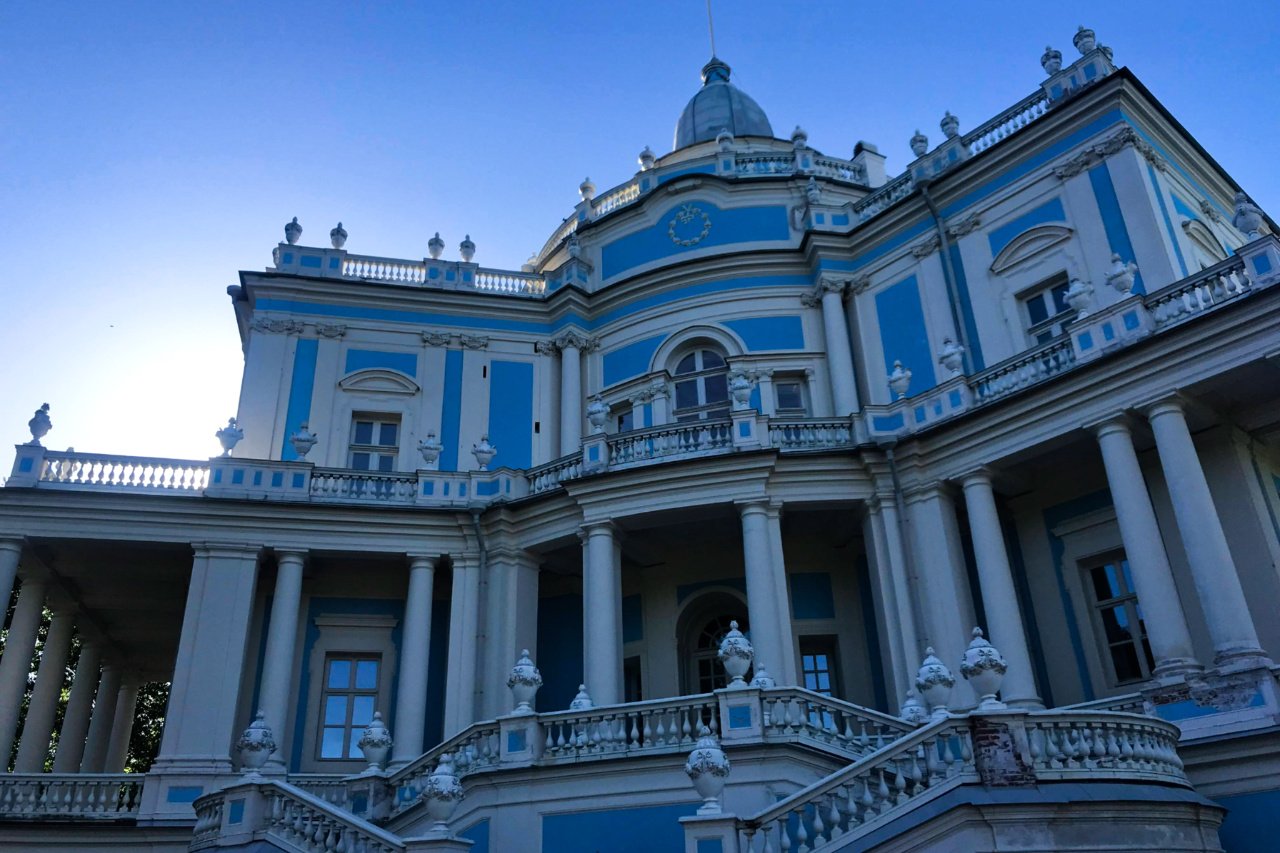
Where to eat and sleep in Peterhof
There are several hotels in the city and many locals rent out their flats in the season through various international accommodation sites.
Probably, the most popular is the New Peterhof Hotel, featuring a spa and an indoor pool, situated next to the Olga’s Pond and a stone’s throw from the entrance to the Lower Garden. It also has a decent restaurant, Duck and Drake, where you can have lunch, dinner, or take-away food.
Another accommodation site in the same area, Samson Hotel, is situated in a historical building and it offers budget accommodation.
There are quite a few cafes and restaurants along the main road of Peterhof, and most of them have a menu in English. As the town attracts most of its visitors in the summertime, they get really crowded in that period and the waiting time can be extremely long, but off season they will be half empty and fast to serve you.
WANT TO READ MORE? Check out this post → Travel to Saint Petersburg: a guide through a love letter
Liked it? Want to read it later? Pin it!
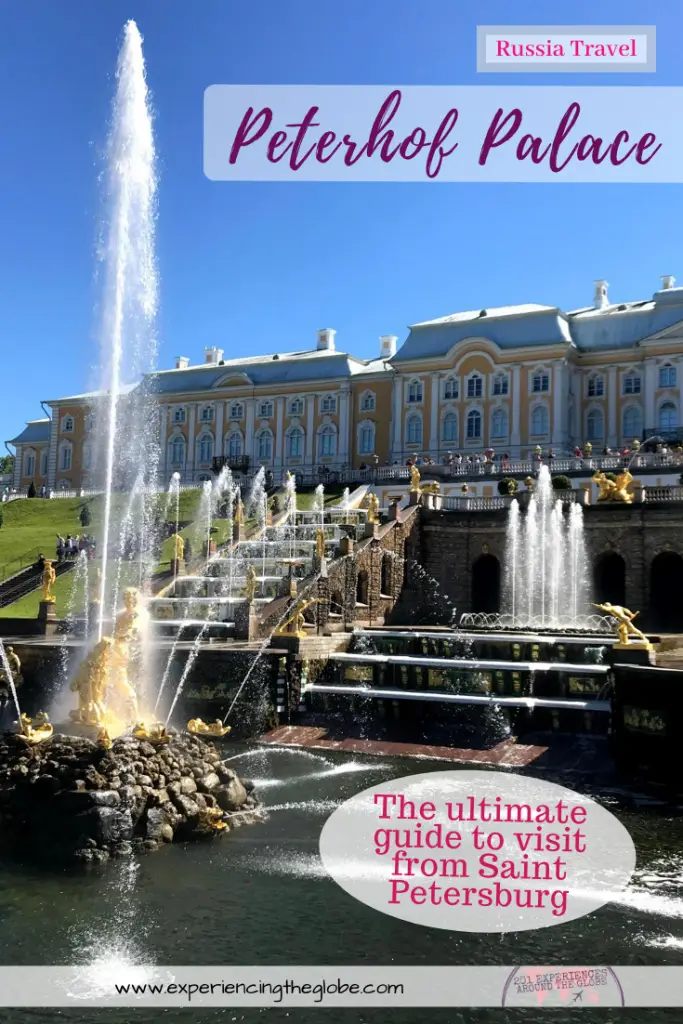
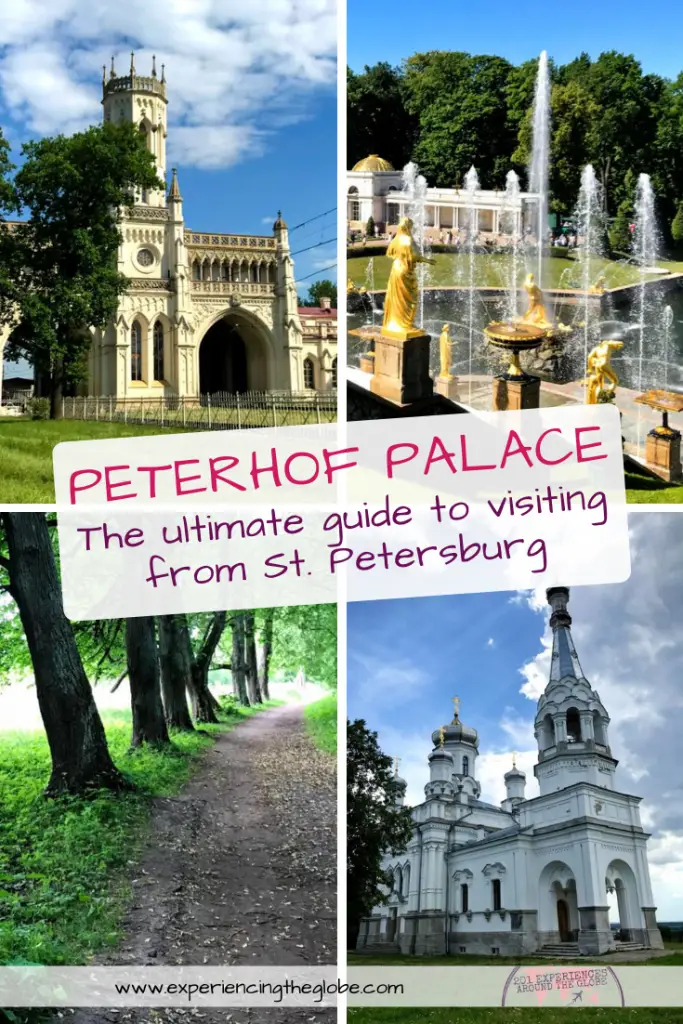
This post about visiting Peterhof from St. Petersburg was written by Alexandra and edited (and translated to Spanish) by Karina.
Karina and Alexandra are two locals from St. Petersburg, who love their native city, Moscow, and other charming locations in Russia. For their project Carusel Tours they create tours for art, history and literature lovers, and write about interesting routes around main Russian cities, Russian food, art, architecture, parks and everything that they feel excited about! Their main goal is to share their insights with you and help you discover non-trivial things and locations, that you won’t find in standard guidebooks and travel diaries.


How lucky to grow up in such a beautiful and historical place. I’m looking forward to explore around every corner you described. I’m saving this guide for when I can travel!
Alexandra and Karina indeed did an outstanding job with this amazingly detailed guide of their hometown. Hope you enjoy your trip with all their insiders’ tips!
Yes, I love this place. Nothing like the Russian Versailles!
It really looks like it was taken from a fairy tale 🙂
This is incredibly detailed!!! I had no idea Russia has so many marvellous palaces and gardens. I particularly loved the Grand Peterhof Palace, which I now can’t wait to visit, and the Peterhof Train Station! Thank you for sharing so many beautiful places that are lesser known but that should be added to everyone’s bucket lists!
Thanks so much for your lovely words, Lauren! It is indeed a gorgeous destinations with tons to offer, and it absolutely should be on everyone’s bucket list. I hope you get to visit soon 🙂
Wow, what a grandiose place! Love all those fountains and the meadow walk is right up my alley 🙂
It’s truly the Versailles of Russia -such a beautiful place! 🙂
This is such a gorgeous place and you did a great job covering it in this post. I am definitely pinning this for future trips!!
Thanks, Michelle! Hope you get to visit soon! 🙂
The palace and the grounds look absolutely amazing. I wish I had allocated time when I had a Russian visa to visit St. Petersburg years ago. The opulence of the former czars’ palaces is in stark contrast to communist-era architecture.
Life might give you a chance to go back. Petersburg and its surroundings are a different world from the rest of Russia, absolutely worth exploring!
I would love to visit Russia! The pavilions look so cool, for sure I’m adding St. Petersburg and Petehof to the itinerary when I do
They are beautiful destinations, I’m sure you’ll love them 🙂
This is a really helpful article! I found it very confusing to visit Peterhof last year, so this will definitely be helpful for a lot of people. I’ll save it for when I return!
Thanks for your kind words, Krista! 🙂